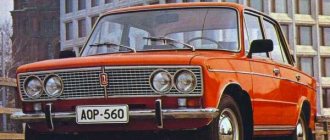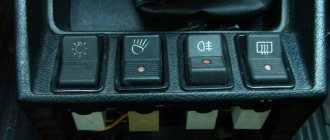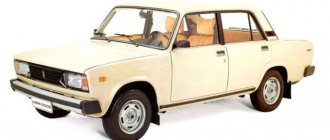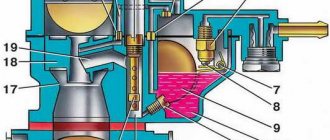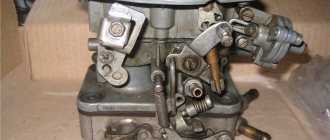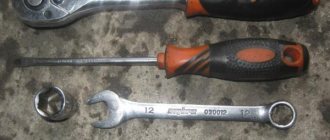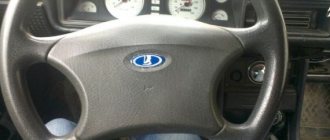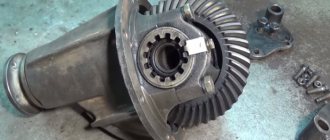| Comparison of dimensions, mm | Lada 2105 | Lada 2107 |
| Modification | 1st generation, 10.1979 — 01.2012, 1.5 l., 71 hp., Gasoline, manual transmission, Rear-wheel drive select another | 1st generation, 03.1982 - 04.2012, 1.5 l., 68 hp., Gasoline, manual transmission, Rear-wheel drive select another |
| Photo | ||
| Country of assembly | Russia | Russia |
| Secondary market price | ~50,000q | ~ 45,000 q |
| Fuel type | Gasoline AI-92 | Gasoline AI-92 |
| Body type | Sedan | Sedan |
| Transmission type | Manual transmission 5 | Manual transmission 5 |
| type of drive | Rear (FR) | Rear (FR) |
| — | — | |
| Engine capacity, cc | 1452 | 1452 |
| Power | 71 hp | 68 hp |
| Maximum torque, N*m (kg*m) at rpm. | 112 (11) / 3500 | 104 (11) / 3500 |
| Fuel tank volume, l | 39 | 39 |
| Number of doors | 4 | 4 |
| Trunk volume, l | 379 | 379 |
| Acceleration time 0-100 km/h, s | 17 | 17 |
| Weight, kg | 976 | 1060 |
| Body length | 4145 | 4145 |
| Body height | 1446 | 1446 |
| Wheelbase, mm | 2424 | 2424 |
| Ground clearance (ride height), mm | 170 | 170 |
| Fuel consumption, l/100 km | 8.8 | 8.5 |
| Rear wheels | 175/70 R13 | 175/70 R13 |
| Number of places | 5 seats | 5 seats |
| Owner reviews | Lada 2105, 1st generation, 10.1979 - 01.2012 VERY cheap to service, can be repaired on the highway. Lack of dynamics, lack of comfort, low quality of spare parts During the 8 years of use it was changed: rear axle gearbox twice, axle shaft assembly, shock absorbers twice, ball joints and silent blocks 3 times, crosspiece, gearbox repair. That's all, except for consumables, the engine has not been repaired and to this day the mileage is more than 230 thousand km. The car has been used by its brother for more than 5 years Warm interior Chassis Passable Comfort | Lada 2107, 1st generation, 03.1982 - 04.2012 Although the “tank” is not for women, I’m already used to it. When I sat down with her for the first time (she neighed like a horse), I don’t know why...probably because she was tossed in all directions. I live in a rural area not far from the city, so I have to drive over bumps, around the city, and on the highway. There are no problems driving around the collective farm, because... The suspension is soft, in the city it hasn’t gone anywhere yet, but on the highway it’s amazing! It throws its ass in all directions, holds the road poorly, and has difficulty taking turns. But really, I’m not afraid that it will break and I’ll get into money or lose money (because of the relaxed handbrake, I kissed the fence =) I don’t know about other drivers, but after driving a “bucket” my back hurts terribly = (the lighting in the low beam is bad, I constantly have to peer at the road, almost into a hickey with the windshield. The turn signals always fail at the wrong time. There was no protection, so when I was driving along the highway in the pouring rain in extreme conditions, water poured straight into my face through the steering wheel and from under the gearbox almost…..well…well, it’s okay, the car is still fire, I can’t even dream of anything better, and I drive I’ve been using it professionally for 2 years already (not like chickens on automatic machines). Sorry to anyone I offended =)))))))))))))))) this fucking 4-mortar, I suffered! From third I changed it to 5 and (fire!) I changed: starter, retractors, chocolate bar, pendulum, anchor, fuel pump, brushes, oil, float, steering wheel (the old one broke while driving, I drove home using the key - this you should have seen it!), brake pads, the generator was rebuilt twice, but the engine runs like a clock, doesn’t consume oil. The brakes are of course lousy, you have to brake almost a kilometer away. Durable, the engine always starts in a jiffy Cheap to maintain Fuel consumption, brick aerodynamics. Quality of spare parts Cheap spare parts Breaks often |
Appearance
The exterior of the cars is practically the same, only a closer look reveals some differences. The 2107 radiator grille is made of plastic with a special chrome-plating coating; the 2107 has a nondescript version made of non-shiny black plastic. From a practical point of view, a “chrome” grille will be more susceptible to wear and corrosion, and with each washing process the coating will oxidize and then fall out.
VAZ 2105
The trunk lid of the 2107 looks more solid, thanks to the stamped relief, while the 2105 has a completely flat shape. The hood of the car also has minor differences in external similarity; in 2107 it has several additional bulges.
VAZ 2107
The head optics of the 7th model Zhiguli are equipped with a reflective element, which has both a visual difference from the 5th model and a brighter and more directional luminous flux. The 2107's taillights have a square rear light zone, while the 2105's are rectangular. The bumpers of the seventh model are made of carbon steel, while those of the five are aluminum.
The hood and trunk lids of VAZ models differ in the form of stamping. In the “seventh” model of the Lada, the hood lid has a higher relief than the hood of the VAZ 2105. And the trunk lid, on the contrary, in the seventh model has a flat surface, and on the “five” the lid is a stamped part with recesses.
Lada bumpers are made of different alloys. The “five” has both bumpers made of aluminum, while the VAZ 2107 has two bumpers made of carbon steel.
What are the differences between the VAZ-2107 and VAZ-2105
Classic domestically produced VAZ cars attract many drivers who choose affordable models with a low initial price.
But when considering the two models 2105 and 2107, a reasonable question arises as to how exactly they differ from each other. At first glance, these two cars are very similar, but if you decide to look a little deeper, it immediately becomes clear that they are completely different. According to the designers, the seven was supposed to become a luxury car in its line. The Five was a standard car.
Technical part of the machines. If we talk about the technical side of the issue, then a standard car, namely the VAZ 2105, does not have such elements as: a brake pad wear sensor, a crankshaft position sensor, a headlight washer, a generator, a contactless transistor ignition system, an oil pressure sensor and general technical diagnostics
An interesting point is that the luxury version of the model was produced only until 1988, after which the manufacturers made it more affordable and simpler. In the VAZ 2105 the radiator grille is made of black plastic, and in the VAZ 2107 it is chrome-plated. And also the bumper is less durable, but with a more beautiful chrome trim.
Devices. Comparing these two similar models, we can immediately say that the 2107 has a wider range of additional devices that make operation comfortable and safe. There is space in the cabin for a radio and, in general, the instrument panel looks more modern and interesting.
The interior also has different seats, which are more comfortable and comfortable in the 2107 due to the fact that the owners of the 2105 constantly complained about this drawback and the manufacturers wanted to improve it, which they actually managed to do in the end, adding real comfort and amenities.
Other differences. The trunk lid of the “five” has indentations, while that of the “seven” it is absolutely straight and smooth
This is not so important, but still a difference that simply cannot be ignored. Another difference is the taillights, which are slightly different on the 2107 and shine with a warmer light due to the use of different bulbs
Experienced drivers. For experienced motorists, all these differences are too obvious, but beginners sometimes cannot distinguish one car model from another
Perhaps, the difference between these domestic cars is really not significant, although manufacturers have always paid attention to this, considering all the differences important and conspicuous
Conclusion. Domestic classic models can be purchased on the market at an affordable price. But potential buyers should understand that the build quality of the main components is appropriate, so you cannot count on a high level of comfort and convenience, regardless of which car is chosen, VAZ 2105 or VAZ 2107, especially since both cars are in the same price category.
Interior
The interior of the VAZ seventh model is distinguished by the presence of additional functional options:
- The seats for the driver and passengers of the VAZ 2107 are equipped with headrests, which the Lada “fifth” model cannot boast of.
- In the 7's interior heating system, air is taken in through a central air duct in the engine compartment. For the “five” heating system, the air passes through the radiator.
- The dashboard of the Lada “seventh” model has a tachometer and a fuel economy sensor.
- On the very first VAZ 2107 cars, produced in the 80s, brake pad wear and engine oil pressure sensors were installed.
- The VAZ 2107 car had speedometers with a marked scale up to 180 km/h. On the “fives” the speedometers are marked up to 160 km/h.
- The VAZ 2107 interior is equipped with cold air flow deflectors responsible for ventilation.
- On more modern versions of the VAZ 2107, the visual appearance of the door trim, headliner, and plastic trim on the rear pillars has changed.
- Initially, the “seven” was distinguished by a new radio panel, the shape of the steering wheel, and the appearance of the gear shift lever. Subsequently, these innovations also affected the interior of the Lada “fifth” model.
- On the central console of the VAZ 2107 there is a clock and there are connections for the car radio. The “five” only has an inconveniently located hole for installing a radio.
In the fifth version, these options are missing, there is only an inconvenient cutout for the car radio. The interior heating system in the VAZ 2105 model takes air directly from the heater radiator; in the 2107, the air enters directly through the central air duct, through an opening in the engine compartment.
What is the difference between the VAZ-2105 and the VAZ-2107
Many inexperienced car enthusiasts are not able to distinguish a VAZ-2105 from a VAZ-2107. And indeed, these cars are so similar to each other that you can’t help but wonder: how can they differ from each other? In fact, there is still a difference between them, and we are talking not only about the “insides”, but also about the exterior of the car. Of course, at first glance it is difficult to find any difference between one car and another, but if you look closely, you will notice some features of different models. Today we’ll talk about how the VAZ-2105 differs from the VAZ-2107 externally, internally and technically.
External differences
Do you think that there are no differences between the “five” and the “seven”? Take a closer look at these cars, examine them in more detail
In fact, there are some nuances in the exteriors of these cars that you should pay attention to
- Radiator screen. On the 2105 model it is made of black plastic, while on the 2107 a more modern option is used: chrome-plated metal.
- Different headlight structures.
- The trunk lid on the “seven” is perfectly flat, while on the “five” it has small depressions.
Of course, apart from the radiator grille, it is quite difficult to notice the difference between the cars. However, it is also not a key indicator
Therefore, it is recommended to pay attention to the headlights
It should be noted that models 2107 and 2105 are very, very similar to each other, so it will still be quite difficult for an inexperienced car enthusiast to find at least some differences.
Differences in the cabin
Before looking under the hood of these cars, let's first go through the interior, there are more differences here. “Seven” is a more modern car, so even Soviet designers were puzzled by the high-quality equipment of the torpedo. On the instrument panel of the VAZ-2107 you can find the following options that the “five” does not have:
- Tachometer.
- Econometer.
- Availability of a special console designed to connect additional equipment.
Model 2105 only boasts an input for audio devices. Moreover, the previous generation of Soviet engineers “did their best” by hiding it so inconveniently that getting to it right away is not so easy.
Another characteristic feature of the “seven” is the specific design of the seats. On this model, AvtoVAZ has already used sofas with special headrests. You won’t find anything like this on the “five”, unless the car owner himself has replaced the interior with the installation of new seats.
Technical features
For some reason, many are sure that the main technological advantage of the 2107 model over the 2105 is the presence of an injector. Actually, this is not true. The injector came to all VAZ cars over time. It is difficult to say for sure when exactly this happened. Some sources claim that in 2006, others say the 90s, and still others even talk about 1989. Let us emphasize once again: the injector should be considered the difference between an old car and a new one, but not a “five” from a “seven”.
If we talk specifically about the differences, the following features can be highlighted:
- different ventilation design. A deflector is installed on the VAZ-2107, thanks to which the car receives cold air directly from the outside. The VAZ-2105 uses an outdated cooling system through a heating radiator;
- piston and cylinder size. On the 2105 it is 66 × 79, and on the 2107 it is 80 × 76;
- acceleration time to 100 kilometers per hour. If the “five” takes 18 seconds to do this, then the “seven” will do it a little faster – in just 15.
You can also pay attention to the difference in power between cars, but again here it is worth taking into account the year of manufacture of the vehicle. The old “fives” have engines with 69 horsepower, and the “sevens” have 77 liters.
With.
At the end of the article we will add a little about the similarities. Firstly, both models are rear-wheel drive. Secondly, an identical body is used, which makes them so difficult to distinguish. The components for the cars are practically the same, so situations are not uncommon in which the 2105 has a gearbox, steering gear, and suspension from the 2107 and vice versa. The cars are very similar to each other, but you can still find differences if you want.
Engine
The Lada seventh model is equipped with both carburetor and injection engine modifications. In the carburetor version, the VAZ 2107 has an advantage in power by 8 horsepower, its power unit produces 77 horses, and the 2105 engine produces 69. In addition, the seven has an increased piston stroke and cylinder diameter, in the proportion: 67x69 to 80x76, respectively. The displacement of VAZ carburetor engines of the seventh model can be from 1.3 to 1.7 liters, depending on the modification, the five also have several modifications from 1.2 liters to 1.6, there are 2105 with an engine capacity of 1.45 liters , but this is a rare option.
In motorsport
VAZ 2107M, a model intended as a replacement on the assembly line for the VAZ-2107 VAZ 2107M rear view
- This car is very popular in Hungary, where it has long become a cult car, and is widely used in motorsport (mainly in rallies);
- 2006—2010. Russian Classic Rally Championship - Grigory Novichikhin;
- 2010—2011. Russian Circuit Racing Championship (RTCC) - No. 77 Vladislav Kubasov, Team: VPK SPORT;
- 2012. BATTLE ROBOT CAR competition in Astrakhan, in which the VAZ-2107 was equipped with a remote control.
Rally Bohemia 2012 in the Czech Republic
New version of the traffic police
Injection system
VAZ 2107 cars have recently been produced with an injection engine with a power of 73 and 77 l/s, with a displacement of 1.6 liters. The injection version has an electrically driven fuel pump and a main electronic engine control unit, which is responsible for the operation of many vehicle systems. Fuel consumption has decreased significantly compared to the carburetor version.
Both car models are equipped with a manual transmission system, with four or five gears, depending on the modification. They have a single-disc clutch type and rear-wheel drive with a cardan drive. The brake system of 2105 and 2107 is identical, the rear wheel brakes are drum type, the front wheels are disc brakes. Both cars are equipped with standard 13-inch wheels.
Tuning
The VAZ 2107, along with other “classic” models, is one of the most tuned Russian-made cars. Its cheapness, on the one hand, and outdated design, on the other, force many owners over time to make efforts to modernize the car.
For example, installing hydraulic compensators on the engine results in a noticeable reduction in engine noise and an increase in timing belt life. We also offer ready-made kits for replacing rear drum brakes with disc brakes.
Due to the large volume of classic cars in use, manufacturers of spare parts offer a lot of finished industrial products to improve consumer properties, and even conveyor suppliers offer “improved” products to replace their own components (for example, a heater motor on bushings from the factory - change to a motor with bearings). The “classics” segment probably has the widest selection of spare parts that differ from the factory equipment.
Other characteristics
- The acceleration of the VAZ 2107 model to “hundreds” thanks to a more powerful engine is 15 seconds versus 18 seconds for the “five”.
- The maximum speed that the Lada “seventh” model can reach is 155 km/h. For the VAZ 2105 this figure is 145 - 150 km/h.
- The weight of the cars differs slightly. “Five” weighs 995 kg, “seven” - 1035 - 1050 kg, unlike the modification. The carrying capacity of both cars is 400 kg.
- The ground clearance of the VAZ 2107 is 175 mm, which is 5 mm more than that of the opponent.
- Cars have differences in the electrical system layout.
- The price of a VAZ 2105 in the last years of production of the car (2009 – 2010) was about 175 thousand rubles. VAZ 2107 cost about 190 thousand rubles.
Disadvantages to watch out for
How to learn to understand car engines
But it was not without its drawbacks either. VAZ 2107 and VAZ 2105 have certain shortcomings that prevent car enthusiasts from making a choice in favor of these particular models.
Tuning of domestic cars
- Due to poor design, the wipers clear a very small area of the windshield, making visibility difficult in adverse weather conditions.
- The steering wheel is too large in diameter, which can be a real problem for a “large-sized” driver. But on the “seven” the steering wheel is more comfortable due to its matte structure. It does not slip in your hands, which cannot be said about the steering wheel of the “five”, so it is better to immediately purchase a steering wheel cover if you buy a 2105.
- The side mirrors are too small, making visibility difficult. The problem can be solved at the nearest service station, but requires additional investment.
- The steering wheel is tight and the braking distance is long. The driver needs to get used to it in order to drive the car carefully and safely. The lack of amplifiers on the steering system is a significant drawback.
- The “internal filling” of models of recent years of production tends to creak when driving over uneven surfaces. This is explained by the poor quality of the plastic from which the internal front panel and instruments are made.
- The location of the pedals will not be convenient for everyone: you will have to master the “wide seat” in order to maneuver skillfully. The pedals are placed high and too far apart from each other, but for drivers who have been driving the “classic” for many years, this feature is completely invisible. Only beginners who have learned to drive foreign cars will see it.
- Models are too noisy. They cause real migraine attacks in some drivers and force them to contact car services for soundproofing work. The “symphony” of aerodynamics and transmission, the “melody” of seals and the “bass” of the engine can become a real problem for a car enthusiast.
And what is better: to buy a VAZ 2105 or a VAZ 2107? Each driver must give the answer to himself. The higher price of the 2107 is compensated by additional devices and a rather presentable front bumper. In all other respects, these are almost identical models.
Many car enthusiasts will think: why compare obsolete models that have already been replaced by Lada Granta? The answer is simple: Lada Granta replaced classic cars on the assembly line of the Tolyatti automobile plant, and the VAZ 2105 and VAZ 2107 continue to be produced by the Izhevsk plant. Thus, the rear-wheel drive “five” and “seven” remain the most inexpensive and unpretentious vehicle in the domestic automobile industry.
What do the Five and the Seven have in common?
From a technical point of view, this is one car , and the difference between the base and modified model is minimal. In the modern understanding, the “Seven” is essentially a restyled “Five”, designed to spur the interest of car enthusiasts in the “classic”, which is inferior to the market, and the more promising “Samara”.
The use of steering rods and worm gears was not modern even in the 1980s. This device had a small resource, and driving such a car required increased attention from the driver. However, the stress when driving was aggravated by the car's ancient suspension, which caused excessive rolliness when cornering . Both the unreliable hydraulic clutch, prone to breakdowns, and the high-temperature-sensitive mechanical fuel pump, which “boiled” at the most inopportune moment on the road, played their role. To keep the “classic” in proper condition, it was necessary to often look under the hood, change the crosspieces and the driveshaft outboard bearing. But in general, these were “family sores” of the “classics”, inherited from its progenitor - FIAT 124. And therefore well known to the average person since the days of “Kopeyka”.
Simple methods for troubleshooting these cars passed from mouth to mouth for several generations of Soviet and then Russian drivers, which gave rise to legends about field repairs on the knees using improvised means. At the same time, one cannot fail to recognize the exceptional endurance of these machines in the conditions of Russian reality.
How to repair a carburetor yourself
Repair work on the VAZ 2106/2107 carburetor involves removing and disassembling the mechanism. In this case, the repair includes all two stages:
- Washing (cleaning, blowing) elements from carbon deposits and adhering dirt.
Replacement of worn or failed parts.
Before carrying out any actions with the unit, you must firmly make sure that the carburetor is faulty. Often, incorrect operation of other systems can affect the performance of the carburetor mechanism.
The carburetor is located under the hood, above the engine.
Troubleshooting
DAAZ carburetors of any modification are designed to operate stably regardless of operating modes. However, it is precisely the change of modes (for example, starting “cold” or accelerating when overtaking) that can show the first problems in the operation of the device. The carburetor is clearly faulty if:
- at idle there are failures in engine operation;
while driving, a time interval is noticed between pressing the gas pedal and accelerating the car;
jerks in engine operation at high speeds;
a series of jerks when overtaking;
Gasoline consumption has increased significantly;
Difficulty starting the engine after long periods of parking.
Each of these signs, as well as their combination, indicates that there is a problem with the carburetor and repairs or adjustments are necessary.
Overflows
One of the most common problems with carburetor engines is the so-called overflow. An excessive amount of fuel is supplied inside the device, and for some reason the check valve is not able to drain excess gasoline back into the tank. Therefore, under the carburetor and on it itself, the driver may notice drops of fuel.
Shoots
This concept is inextricably linked with transfusion. If the carburetor begins to shoot (or sneeze) - that is, jerk sharply while driving and even ignite - there is a fuel leak. The mechanism needs to be flushed.
Gasoline is not supplied
The problem may lie either in the carburetor itself (the jets are seriously clogged or the pump is broken) or in the supply hoses. It is recommended to blow out the fuel supply pipe and test the operation of the fuel pump. If they function normally, you will have to remove the carburetor and wash it.
The secondary internal combustion chamber does not work
Failure to operate PIC No. 2 will immediately affect the vehicle’s dynamism: it loses almost 50% of its original speed characteristics. The problem is that the throttle valve is sticking, which regulates the flow of fuel into the chamber cavity. You will have to disassemble the mechanism and replace the damper with a new one.
Which one to choose?
Based on the above, the VAZ-2105 is suitable for those who choose a car for short trips and rarely travel outside their region. An ideal option for rural residents, summer residents, pensioners, students, novice drivers, when there is no point in overpaying for comfort.
The VAZ-2107 reveals its advantages in practice on a long journey. Suitable for traveling with a small group and family, as well as business and work trips. The five-speed transmission contributes to maximum speed and fuel economy on the highway. Often used as an inexpensive taxi in the provinces and on the periphery of our country.
These models have great potential for tuning, and are often participants in amateur races and sports competitions, for example, drifting and street racing, but it would seem that the “classics” have long since sunk into oblivion...
Conclusion - cars 2107 and 2105 have a significant difference, only in the design of the engine, the injection engine is more dynamic and economical than the carburetor engine. The 2107 has a more informative dashboard and is a little more comfortable in the cabin. The cost of 2107 is slightly more expensive, the car looks a little more solid and modern.
Auto and motorcycleComment
VAZ 2106
Compared to the top five, this model has more positive responses on ad sites. This car has five seats and four doors, and is also rear-wheel drive. The car began production 4 years earlier than the five. The car was developed based on the 1972 FIAT 124 Speciale. After some time, this car became the most prestigious after the Volga. 8 modifications of this car were created, including an export version for countries with left-hand traffic.
By the standards of the times of the Soviet Union, this car had a powerful engine of 80 horsepower, the displacement of which was 1.6 liters. The model is often compared with the VAZ 2103, against which it has a slightly different design: a modified radiator lining, different bumpers with polyurethane inserts. The model also illuminates the license plate.
At that time, the car was really good: a high speed of 150 kilometers per hour, comfortable seats, a dashboard with a tachometer and good noise reduction. It’s also very nice to look at the interior of the six of that time. It looks great after renovation and will still look great now.
The car costs a little more than a fiver. And although the minimum price starts from 30 thousand, most offers of used sixes range around 80-120 thousand. Moreover, this price is for cars with fairly low mileage. That is, the offer is definitely profitable.
On one of the ad sites, a 1998 six with a mileage of 119 thousand kilometers in good condition is sold for 135 thousand.
One of the characteristic advantages of the car is its resistance to severe frosts. So, one of the car owners writes that at a temperature of -38 the car started very easily. Users also liked the car heating system. After just 10 minutes in winter, you could ride in just a T-shirt without feeling cold.
Another positive side of the car is its cross-country ability. The car handled well even on rural roads for a non-SUV vehicle.
The owners of the car paid special attention to its maintainability. The machine is unpretentious in maintenance, despite its age, spare parts are very cheap, and repairs can be done independently
Among the shortcomings is outdated design. This car clearly cannot be used to show off status. But from a practical point of view, it is a very good option.
Answers (1)
Purely externally, the cars differ in their radiator grille (the 2107 is chrome-plated and larger in size than the 2105) and the bumpers - although they are very similar, if you look closely, you will find that the 2107 has a bumper with a top made of chrome-plated steel, while the 2105 has a normal, both below and above. I listed the external differences.
Now about the interior. The VAZ 2107 has a high panel, that is, the place for the radio (audio preparation) is located to the right of the dashboard. While the 2105 has a low panel, that is, the radio is located at the bottom. Also, cars have different steering wheels and some other elements.
In general, the 2107 was considered a luxury version of the 2105 model, so many of the parts in the seven are themselves more expensive.
Now for the engines. 2105 was equipped with engines with a displacement of 1.3 and 1.45 liters, with a power of 58.7 hp, 85 Nm and 71.4 hp, 104 Nm.
And model 2107 had a 1.6-liter engine under the hood, producing 80 horsepower.
History of creation
The main overall dimensions of the VAZ-21011 VAZ 2101 Lada
VAZ 2107 is a modified luxury version of the VAZ 2105. The first models were presented to the country's leadership in 1978, and serial production began much later, as was already said in March 1982.
The VAZ 2107 was exported under the names Lada Nova, Lada Riva, Lada Signet, Lada 1500.
In 2001, a model configuration program was developed. VAZ 2107 was available in “norm” and “standard” versions, and for VAZ 21074 – “norm” and “luxury”.
From 2002 to 2012, the VAZ-21070 (modification of the VAZ-2107) was produced in Ukraine (LuAZ, ZAZ and KrAZ). In May 2008, the assembly of the VAZ 2107 was established at Argun in the Chechen Republic. Since March 2011, the production of the “Seven” has been mastered by the Izhevsk Automobile Plant.
In April 2012, the AvtoVAZ concern decided to finally stop production of the classic VAZ2107 sedan. This decision was made due to the greatly decreased demand for this model, as well as due to the acceleration of work in Izhevsk to prepare production for the release of the Lada Granta. The last VAZ 2107 sedan rolled off the assembly line on April 17, 2012. In Egypt, LADA 2107 was assembled until the beginning of 2014.
Production of the 2104 station wagon, unified with the sedan in terms of power plant, exterior and interior of the front part of the body, continued until September 17, 2012.
In March 2022, the analytical agency Autostat conducted a study, according to the results of which the VAZ 2107 sedan became the most popular passenger car in Russia. At the time of the study, this model was driven by 1.75 million Russians.
There are no particularly sharp turns in the history of the VAZ 2107 production. Good exterior and interior design has been positively received for many years. The only major change was the use of distributed injection on this model.
Technical part
The electric platform of Renault Nissan, on which the new Zhiguli will be built, involves the main front drive wheels, unlike similar platforms of the Volkswagen and Hyundai concerns. The latter are rear-wheel drive by default. This means that the basic version of the new Lada Zhiguli, which will receive the index “3”, will have front-wheel drive, which is atypical for a Zhiguli.
However, in terms of power, everything is good here - 218 hp. With. Such a machine will have a battery with a capacity of 63 kWh. The range on one charge is an impressive 410 km. The Lada Zhiguli 5 or “five” will be a step higher. Such a car will receive an electric motor with a capacity of 242 hp. With. Its battery is already more capacious - 87 kW-hours, and the power reserve is a very impressive 600 km. The acceleration time to hundreds is 7 seconds for the three, and about 6 for the five.
The top modification “Seven” will receive all-wheel drive. Its electric motors are located on the front and rear axles. The total power of the electric motors is 279 hp. With. It is equipped with an 87 kWh battery. On one charge the car can travel almost 600 km. Acceleration time to hundreds is at the level of 5 seconds.
The top charged version of the Zhiguli is also called the “seven”, but it will receive the Performance index in the name. This modification has a more aggressive appearance, clearly differing in traffic from ordinary Zhiguli.
In fact, it will destroy the M-series model from BMW. The car is equipped with the same battery, but more powerful electric motors. Their total power is 394 hp. With. This is already a real combat classic.
Just think about it - acceleration to hundreds is 4.2 seconds! The power reserve, of course, is slightly less than that of the simpler version - 550 km. The large mass and powerful engines have an effect. The car supports charging from the home power supply. A 22 kW charger is also included. It is possible to use high-speed charging stations with a power of 130 kW. However, there is no such infrastructure in Russia yet, but it will definitely appear in the future.
According to marketers, the new Zhiguli is aimed at young people and active representatives of the older generation.
Wheel rim parameters for model 2108
Like the 2107, the 2108 featured 13-inch forgings from the manufacturer. On the Lada Nine (VAZ 2109) with five doors, R13 wheel products were also used.
Tire parameters: 165/70/R13, 175/70/R13.
However, unlike the seven, the eight used discs with the following parameters:
- width 5J;
- departure ET40;
- drilling 4×98;
- diameter of the central hole is 58.6 mm.
Also, depending on the modification, wheels with sets of tires could be used on the eight and nine:
Treant Protector
Trent rarely appears in high-mmr public pages. This is because he is not that flexible in items compared to other supports. Tranquils, meteor, blink, aganim - everything he needs. In patch 7.28, he returned the ability to interrupt the actions of victims when using Overgrowth and added Natures Guise thanks to Aghanim's Shard. Root + good damage - good for the team.
Changes
In the new patch it was only slightly strengthened. Icefrog understood that no one would just buy the fragment. Why break an item build that already works well? Therefore, Trent was given additional speed, thanks to which he began to move quite quickly around the map. With this fragment, he becomes a truly elusive support, capable of placing Vision in the most unpredictable places for the enemy.
Nature'S Guise - Aghanim's Shard now increases movement speed in trees by 15%
The character's overall win rate constantly jumps from 52 to 50-51 percent, but never drops below, which is good news. Possessing a heavy poke at the very beginning of the game, he can easily drive the enemy three and four out of the lane, giving his core complete freedom of action. However, you should not take it against the same Batrider or the currently popular juggernaut and you will be happy.
